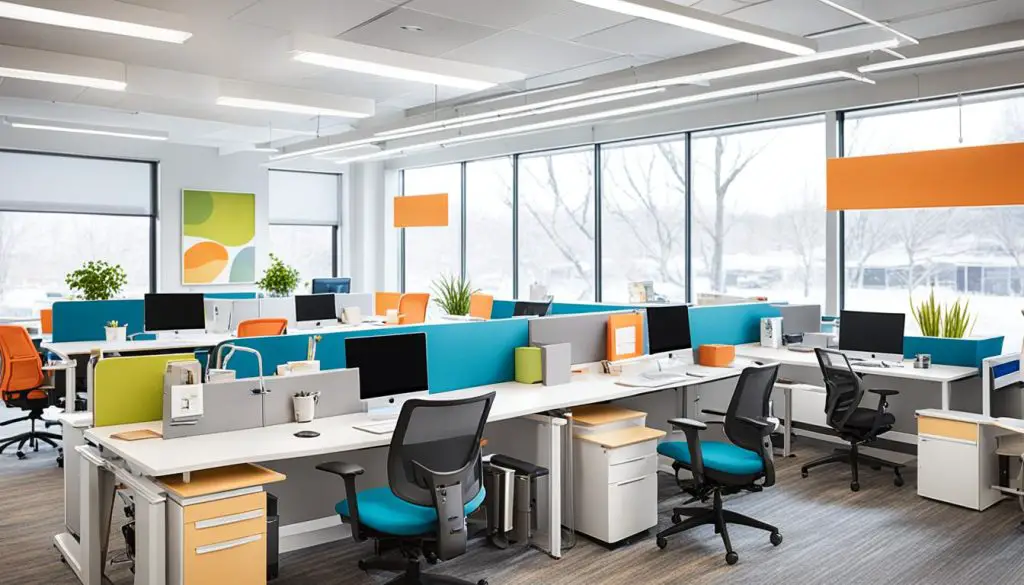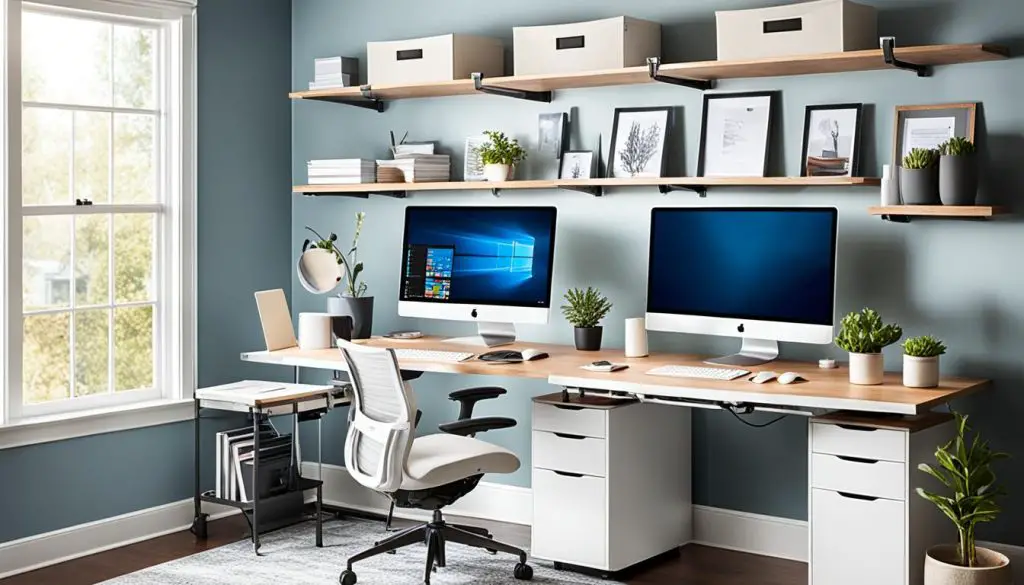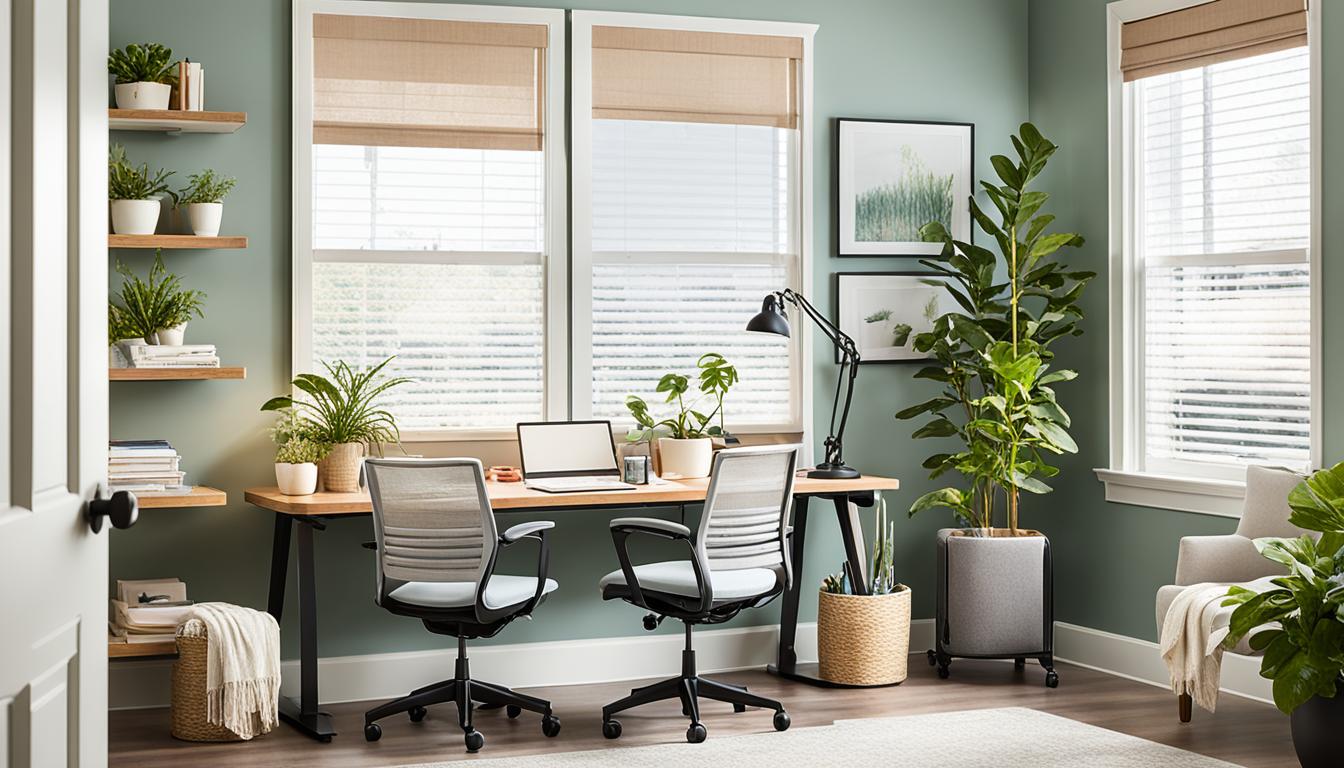Can your home boost both work and health, even with a chronic illness? The answer is in smart home design that fits your unique health needs. I’ve seen how a custom home office changed everything for my wife, who battles endometriosis and fibromyalgia. Discover how to make a workspace that’s easy to use, good for your health, and perfect for work, no matter how you’re feeling.
Dealing with a chronic illness makes everyday tasks harder, including changing your home.1 Things like stairs, hard-to-reach cabinets, or a deep bathtub can be a big problem. But, with some smart and affordable changes, your home can be a lot more practical without needing to move somewhere else.1 What’s crucial is to design your home with your health in mind, adjusting as your needs change.
Introduction: Navigating Chronic Conditions at Home
A chronic condition can change everything. It makes your home, work, and relationships focus on new priorities.1 You might feel lost in what to do next. You could be wondering how you’ll manage in the future. Much of facing this challenge is in your own home.
The Importance of Remaining at Home
Staying home is often the best choice for those with chronic conditions. It lets you get the care you need while still living comfortably.1
Challenges of a Typical Home Environment
Yet, many homes aren’t set up for health challenges.1 Things like stairs, high cabinets, or a common bathtub can make life hard for those with conditions.
Personalized Home Design Solutions
Thankfully, there are ways to change your home to fit your needs. With creative and affordable design, you can avoid moving to a care facility.1
Individualized Approach to Home Design
Everyone feels the effects of a chronic condition differently. Your home design can be tailored to your unique needs.1 You might also want to plan for the future, considering your health changes. We’ll think about the regular challenges you face.
Understanding your health now lets us predict your future needs. This way, you won’t need many remodeling projects over time.1 We take care to meet your present and future needs in our designs. This saves you from multiple disruptions and costs.
Understanding Your Daily Routines
We look at your day and how your space can work better for you. We focus on making your home an ideal place to work and keep healthy. This means designing every part to fit your work needs and support your health.
Projecting Future Needs
We also look at how your health may change in the future. This helps us plan a home that meets your needs now and later. This way, your home can always support you as your health evolves.
Going Beyond ADA Compliance
Starting with ADA compliance is a solid beginning for making spaces friendly for all. Yet in our homes, we aim to do more than meet ADA standards. Sometimes, we may need to go against these rules to meet specific needs.
Tailoring Design to Specific Challenges
For example, ADA might say a house needs a ramp by the door. But think of someone with Parkinson’s using a 4-wheeled walker. Going down a standard ramp could be too fast and dangerous for them!1 So, we might make the ramp less steep than what ADA suggests.
At Live in Place Designs, we do more than just follow the basic rules. We aim to make disability-friendly interiors and health-conscious office layouts. Our focus is on bringing chronic condition adaptations that are truly inclusive office planning solutions to life.
Accommodating Equipment and Technology
The right tech and equipment can really help someone with a long-term illness.2 Yet, lots of houses have tight spaces because of narrow doors and small rooms. This can make it hard to get around with a walker or wheelchair.3 Most homes need changes to fit in new assistive devices, tech, and to make it easier for caretakers.4 We plan spaces so they work now and in the future with any needed help.
Creating Maneuverable Spaces
By smartly placing furniture and re-organizing, homes can be easy to use for people with mobility needs or who need extra help.4 This might mean making doorways wider, taking out walls that aren’t needed, and placing furniture in ways that keep paths open.3 The aim is to let everyone move freely at home, even with health challenges. This is thanks to their tech and equipment that helps them get around.4

Pain Management Through Design
Many chronic health issues need special ways to manage the pain they cause.1 This is also true for people who have problems like being sensitive to touch or feeling sad. For example, a warm bath can soothe someone with arthritis.1 On the other hand, a person with autism might feel calmer with quieter surroundings. In designing solutions, we aim to help as much as possible without taking away a person’s ability to do things on their own.
The home setting is key for easing pain and discomfort for those with chronic conditions. We can improve their daily life by creating spaces designed for their unique needs. Such design may involve layouts that keep health in mind, adjustments for chronic conditions, and plans that include everyone herewith.
Consider someone struggling with arthritis. They might find relief with appliances and counters set at a height to lessen bending.1 Having plenty of room and chairs for tasks that can be done sitting down is also helpful.1 Plus, adding grab bars in the right spots and a comfortable bathtub for soaking can truly make a difference.1 On the flip side, those with memory loss or dementia would benefit from quieting down the noise, increasing light to prevent tripping, and using simple smart gadgets for safety.
Designing with each person’s pain management in mind makes their home a better place. It boosts comfort, soothes the spirit, and allows for freedom – all vital for those battling long-term conditions.1
Holistic Design for Overall Well-being
We blend physical and occupational therapy goals with a holistic approach. We aim to support every part of a person’s life. This includes their mind and soul. It’s about more than just the physical space we create. We focus on how to make them feel better emotionally and mentally, which is just as important. Helping them enjoy what they love, such as hobbies and friends, is a big part of this.
Incorporating Hobbies and Interests
We ask not just about their current life, but about life before the illness hit. Learning about their old hobbies, jobs, and favorite places is key. It helps us fill their space with familiar and loved items. This makes the space comforting and personal, enhancing their well-being.
Creating Comfortable Visitor Spaces
We might design a cozy corner near the bed for easy visits from loved ones.This setup can bring a lot of emotional comfort. It also supports an ergonomic workspace, health-conscious office layouts, and other special adaptations for those with health challenges. It’s about making every aspect of the space welcoming and supportive.
Biophilic Design: Bringing Nature Indoors
This design approach focuses on adding natural features inside. It connects us to nature, boosting our health and happiness.5 Small home improvements can make spaces more peaceful. This is especially good for people with long-term health issues.
Natural Light and Materials
Skylights and big windows fill a room with sunlight. This not only lifts moods but also calms us. Using materials like stone and wood adds to the relaxing vibe. It makes a room feel natural and cosy.5
Incorporating Greenery
Adding a green wall or lots of plants can make a room very calm. Even a small plant can freshen the air and relax us. Adding these touches to workspaces or homes can really help everyone feel better. It improves the space for people with specific health needs too.
Aesthetics and Personal Style
We aim to keep or upgrade your favorite look as part of our holistic design. We follow guides and use tools to steer our clients towards a design that fits them. This design should feel right and even spark creativity. So, “functional” isn’t just about being “sterile” or too clean. We design spaces using principles that make it work for everyone, without focusing on anyone’s disability. This way, we highlight what a person can do, not what they can’t.
Knowing how personal aesthetics improve life for those with health issues is important.1 It would be great to have info on how sticking to your own look and style at home makes you feel good. It helps you feel comfortable and inspired, without focusing too much on health problems.1
We make living spaces that show off who you are and help you stay well. It’s not just about making sure things work right.1 We take a complete approach to design. It’s about making the workspace easy to use, the home welcoming, and the office good for your health. It covers what you need practically and emotionally too.
Home Office Chronic Illness Design
Dealing with illness or a disability is tough. But it shouldn’t mean you can’t work. Thinking creatively and being adaptable can help you keep working happily, even with health challenges.1 This article shares advice on working effectively from home. It also talks about how to build a great career despite your challenges, all while taking care of your health. I prove that life and career interest doesn’t stop after a chronic illness diagnosis.1 Working from home with a chronic illness has been fulfilling. It has kept me happy and involved in the world around me.
Unfortunately, many homes are not built for people with disabilities or health issues. They might lack ramps, special bathrooms, or space for medical aids.1 But with the right Home Office Chronic Illness Design, you can make your workspace comfortable. This design includes working from home and office setups that meet your health needs. It helps you feel good, working in a place that supports you.
Setting up your home for a chronic illness is often cheaper than moving to special care places. You can adjust your space exactly how you need it. This is great for changing health needs and personal care plans.1 Adding natural elements like light and plants can boost your mental health too. A space that feels good can help your well-being.
Imagine an office designed for your health and needs. It lets you keep doing what you love, independently. This health-conscious office layout and inclusive office planning is key for those with chronic illnesses.1 It shows that you can still chase your dreams, all while managing your health.
Addressing Specific Chronic Illnesses
Arthritis
Home changes can really help people with arthritis. Putting counters and appliances up high can lessen how much you need to bend1. Having many seats everywhere, even in the shower, lets you do tasks like sitting down. This can help a lot every day1.
Using grab bars and making floors non-slip reduces falling risks1. Lightweight and easy-to-use kitchen tools are a smart buy. Finally, a bathtub for warm water can relax your joints1.
Dementia and Alzheimer’s
Living with dementia or Alzheimer’s is hard. But, changing your home can make it safer and boost life’s quality. In the beginning, adding cameras helps watch over your loved one. It keeps them safe and cared for1.
Putting up photos of family is nice, especially when labeled1. Clearing up cabinet doors so things are easier to find is smart. Using smart devices can also make it safer at home1. Good lighting helps prevent falls1.
As things get worse, you want to think about stopping wandering. Designing the home to help with confusion is important1.
These changes make life better for those with arthritis, dementia, or Alzheimer’s. Being thoughtful in designing homes and offices can really help. It leads to more independence and comfort, improving well-being1.

Maximizing Independence and Comfort
We create designs that support independence while offering assistance. Our aim is to enable individuals to keep their independence and well-being. We do this by looking ahead to future needs, using advanced tools and devices, and making designs that tackle specific problems.
12%–30% of people in big states in 2014 didn’t have health insurance or couldn’t get necessary care.6 We make places with disability-friendly features and chronic condition support. This includes things like counters that can be changed in height, wide doors, and special lights for people with sensory issues.
Our workspaces and offices are designed for health and comfort. They have smart technology and custom furniture. This helps people deal with health issues and stay productive at home.6
We believe in making spaces that fit everyone’s needs and likes. This means paying close attention to each person’s requirements. Our process creates homes that boost independence, comfort, and happiness.
Creating a Supportive Home Environment
Someone with a chronic illness needs more than just a place to stay. They need support that’s both emotional and psychological.7 Conditions like migraines, chronic pain, and depression change a person’s life. These illnesses affect not just the body, but also feelings and interactions with others.7 To stay well with a chronic illness, you must keep making changes. These changes help your mind, body, and social life stay strong.7 Staying well is about more than just treatment. It’s also about living in a way that helps you avoid getting sick.7
We can make living spaces better by mixing hobbies, interests, and close friendships into them.1 This way of designing lets people with chronic conditions live well without feeling limited by their illness.1 For example, adding a cozy area next to a bed makes it easy for loved ones to visit.1 A warm and personal living spot does wonders for someone’s state of mind when they’re facing a lot.
We think a lot about how a living space affects a person’s mind and mood during the design phase.7 People with chronic illnesses go through a lot of stress, not just physically but also mentally and emotionally. Their home should be a place that lifts their spirits and helps them live well.7 Finding and treating chronic illnesses early makes a big difference in how much joy life brings.7
Tailoring Design to Your Prognosis
Living with a chronic condition, I’ve learned it progresses differently for each of us. So, designing a home should meet your unique needs and look ahead.1 We’ll adjust your living space just for you, making sure you’re comfortable.
In our work together, we’ll watch closely how your challenges change. Then, we’ll predict how your illness might affect you in the future.1 This way, we design a home that fits both now and later, saving you from big changes and costs later on.1 Because redoing your home to age in place can be a big deal, and we want to do it right from the start.
By customizing your home design for your illness, we make a space that helps you remain independent and comfy, no matter how your illness changes.1 This personal touch to chronic condition adaptations and inclusive office planning is key. It ensures you feel good and live well at home.
Source Links
- https://liveinplacedesigns.com/how-home-design-can-help-you-live-with-a-chronic-illness-or-condition/
- https://www.dol.gov/agencies/odep/program-areas/mental-health/maximizing-productivity-accommodations-for-employees-with-psychiatric-disabilities
- https://www.themuse.com/advice/working-living-with-a-chronic-illness
- https://www.dol.gov/agencies/odep/program-areas/employers/accommodations
- https://www.ncbi.nlm.nih.gov/pmc/articles/PMC8871637/
- https://www.ncbi.nlm.nih.gov/pmc/articles/PMC5278805/
- https://www.julieannrachelle.com/blended-decor-blog/wellness-design-for-chronic-illness
